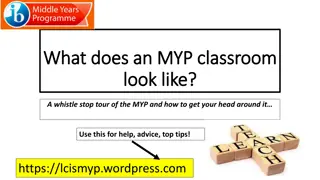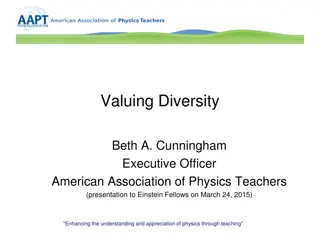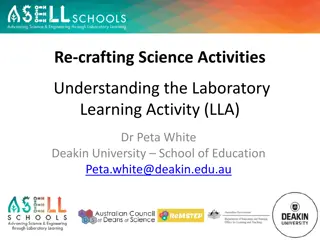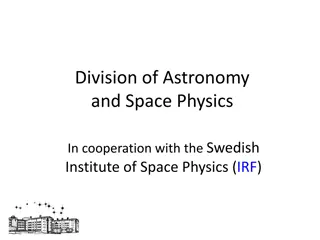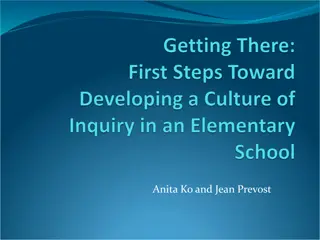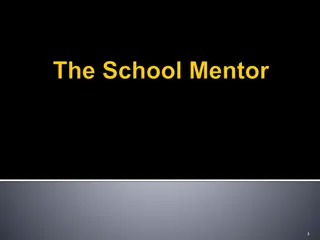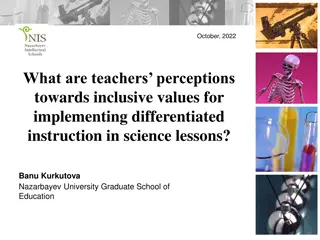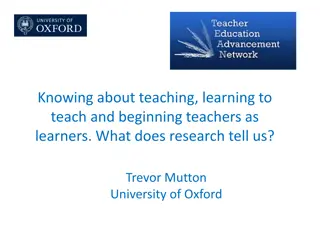Understanding Pre-Service Teachers' Inquiry Teaching in Physics
Lesotho's curriculum emphasizes hands-on activities and inquiry teaching strategies in Physics. However, challenges such as resource limitations affect practical work involvement. This study explores the levels of inquiry implemented by Physics pre-service teachers (PSTs) during their teaching practice, examining reasons behind their engagement in certain levels of inquiry.
Download Presentation

Please find below an Image/Link to download the presentation.
The content on the website is provided AS IS for your information and personal use only. It may not be sold, licensed, or shared on other websites without obtaining consent from the author. Download presentation by click this link. If you encounter any issues during the download, it is possible that the publisher has removed the file from their server.
E N D
Presentation Transcript
PRE-SERVICE TEACHERS ENACTMENT OF INQUIRY IN TEACHING PHYSICS THROUGH PRACTICAL WORK ACTIVITIES S Koma and M Qhobela Sc2024_024 National University of Lesotho
INTRODUCTION Lesotho s curriculum documents advocate for pedagogies allowing students to construct knowledge and engage in hands-on activities. The Physical Science syllabi advise that inquiry be used as one of the strategies in teaching (NCDC, 2019). Inquiry teaching involves engaging students in investigations in which they pursue answers to scientific questions. Some science teachers in Lesotho do not engage their students in practical work because their schools are under-resourced.
INTRODUCTION CONT. Literature on inquiry and practical work in science instruction mainly focuses on in-service teachers or students. One that focuses on pre-service teachers (PSTs) shows that PSTs experience challenges such as lack of motivation from students, limited time to engage students in practical work, students getting unexpected experimental results, or guiding students in designing experiments and making them curious. Literature on Lesotho PSTs enactment of inquiry in teaching Physics through practical work activities during teaching practice is limited. Therefore, this study examines the level(s) and justification of inquiry practised by the PSTs in their practical work lessons.
RESEARCH QUESTIONS 1. Which level(s) of inquiry is evident in the Physics PSTs practical work lessons? 2. What are Physics PSTs reasons behind engaging their students in a certain level of inquiry?
THEORETICAL FRAMEWORK This study is informed by Banchi and Bell s (2008) levels of inquiry. The levels of inquiry depend on the amount of information and guidance given to students.
LITERATURE REVIEW Factors that constrain openness of inquiries include availability of science laboratories, classroom management, and teaching time (Staer et al., 1998). One study in South African high schools shows that physical science teachers at resource-constraint schools practice the confirmation level or no inquiry. While those in privileged schools practice guided or open inquiry (Ramnarain & Schuster, 2014). METHODOLOGY This is a qualitative research study within an interpretive paradigm. Sample: Five final-year BScEd students from one institution in Lesotho. Sampling technique: Only PSTs majoring in Physics and having a video on inquiry lessons in which they were teaching Physics through practical work activities were purposively selected. Instruments: Classroom videos, interviews and lesson plans. Data analysis: Inductive and deductive approaches.
RESULTS Three PSTs engaged their students in confirmation inquiry, while two used structured inquiry. Teacher PST1 PST2 PST3 PST4 PST5 Inquiry Level Confirmation Confirmation Confirmation Structured Structured Experiment Mass and weight relationship Volume of an irregular object Density of an irregular object Heat transfer by conduction Thermal expansion of solids Confirmation inquiry lessons In PST1 s lesson, students investigated the relationship between mass and weight by measuring the mass of a bob and its weight following the provided procedure. Students had to measure the two quantities to confirm that weight is a product of mass and gravitational field strength. This lesson followed one in which the difference between mass and weight was discussed. Therefore, this lesson was confirmation because students were given the question to investigate, the procedure to follow and already knew the expected results.
RESULTS Justification for use of confirmation inquiry PST3 used confirmation because of a lack of laboratory resources as indicated below; R: Why did you provide the students with the procedure? PST3: For the fact that they are unavailable (apparatus), for them (students) to imagine everything would be quite difficult. When asked if he would still give students the procedure if his school had all the necessary laboratory equipment, PST1said: PST1: Yes because they are reluctant to be engaged. R: Where is the reluctance from, from learning difficulties or motivation to learn? PST1: I think both of them, these students are demotivated. According to PST1, students learning difficulties and motivation to learn science are also reasons why some teachers do not engage their students in higher levels of inquiry.
RESULTS Structured inquiry lesson In PST5 s lesson, students investigated the expansion of solids using ball and ring apparatus. The teacher gave students a question to investigate and the procedure to follow. The students task was to follow the procedure and conclude (from their observations) that solids expand when heated. Justification for the use of structured inquiry When PST4 was asked why he made his students follow the same procedure, he responded as follows; PST4: So that we should come to one thing and agree to whether our agreement will lead to the objective of the lesson. This response indicates a belief that only one procedure should be followed in scientific investigations. R: Is it because you suspected that some groups may follow the wrong procedure? PST4: I do think so. The way we do things is different. R: Ok. Why didn t you let them do whatever they were thinking? PST4: The time-bound. Sometimes we give little guidelines so that we do things quickly. From the above discussion, lesson periods also limit teachers from practising guided or open inquiry with their students.
DISCUSSION AND CONCLUSION The findings indicate that PSTs engaged their students in the lower levels of inquiry (Banchi & Bell, 2008). Engaging students in structured inquiry is not unique to these PSTs since Yoon et al. (2012) found that PSTs use structured inquiry more than open inquiry. PSTs reasons for engaging their students in the two levels of inquiry are the scarcity of resources, limited lesson time, adherence to one procedure, Students learning difficulties and motivation to learn The study recommends that the PSTs be supported on how to engage their students in higher levels of inquiry in different conditions.




